An easy tutorial to create and configure a Linux virtual machine on AWS
Cloud computing is a hot topic in today's IT industry. It can provide users with flexible, scalable, and low-cost computing resources and services. Amazon's AWS (Amazon Web Services) is the world's largest cloud computing platform and supports multiple operating systems, including Linux. This article will teach you how to create and configure a Linux virtual machine on AWS, and how to use SSH and SCP for remote management and file transfer.
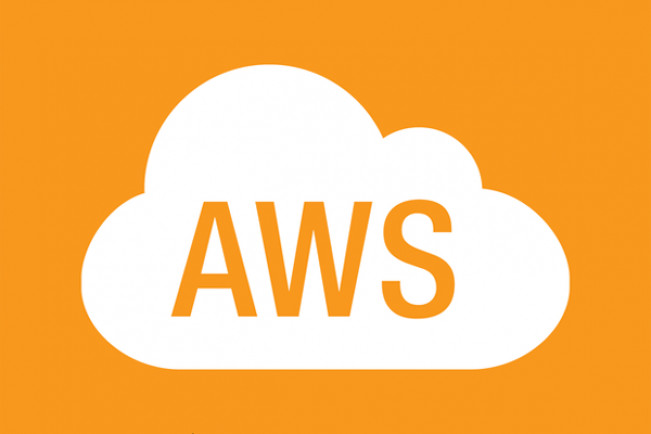
AWS (Amazon Web Services) is one of the world's leading cloud server providers. You can set up a server in under a minute using the AWS platform. On AWS, you can fine-tune many technical details of the server, such as the number of CPUs, memory and disk space, disk type (faster SSD or classic IDE), etc. The best thing about AWS is that you only pay for the services you use. Before you start, AWS provides a special account called "Free Tier". You can use AWS technical services for free for one year, but there will be some small restrictions. For example, you cannot use the server for more than 750 hours per month. Any more than that and they'll charge you. You can view all relevant rules on the aws official website.
Since my article is about creating a Linux server on AWS, having a “Free Tier” account is a prerequisite. Let’s assume you have created a “Free Tier” account.
Before proceeding, you must know some terminology in AWS to understand the setup:
- EC2 (Elastic Compute Cloud): This term is used for virtual machines.
- AMI (Amazon Machine Image): Represents an operating system instance.
- EBS (Elastic Block Storage): A type of storage environment in AWS.
Log in to the AWS console via the following link: https://console.aws.amazon.com/ .
The AWS console will look like this:
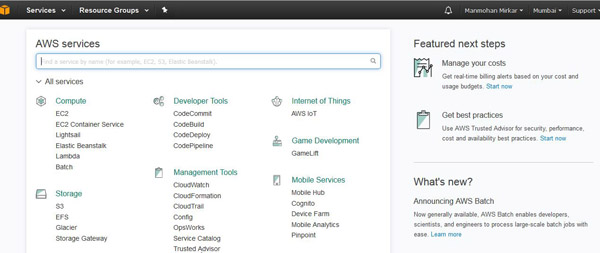
Amazon AWS console
Setting up a Linux VM in AWS
1. Create an EC2 (virtual machine) instance: Before starting to install the system, you must create a virtual machine in AWS. To create a virtual machine, click EC2 under the "compute" menu:

Create an EC2 instance
2. Now click the "Launch Instance" button under Create instance.
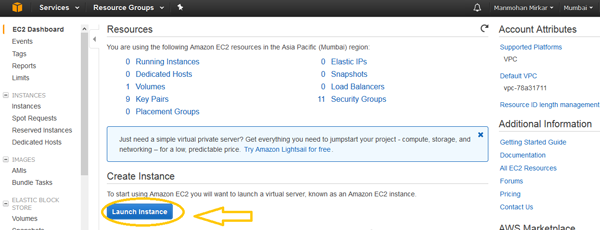
Launch the EC2 instance
3. Now, when you are using a “Free Tier” account, then it is best to select the “Free Tier” radio button so that AWS can filter out the instances that can be used for free. This allows you to not pay for the use of AWS resources.
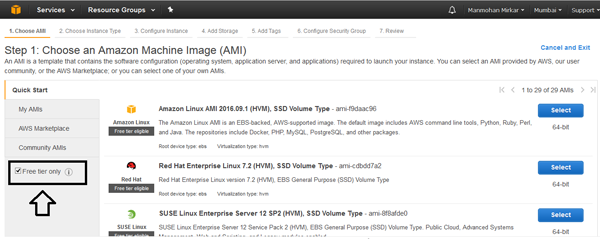
Select Free Tier instances only
4. To continue, please select the following options:
a. Select an AMI (Amazon Machine Image) in the classic instance wizard, and then choose to use Red Hat Enterprise Linux 7.2 (HVM), SSD storage
b. Select "t2.micro" as the instance details.
c. Configure instance details: Do not change anything, just click Next.
d. Add storage: Do not change anything, just click Next as we will use the default 10(GiB) hard drive at this time.
e. Add tags: Don’t change anything just click next.
f. Configure security group: Now select port 22 for ssh so that you can access this server from anywhere.
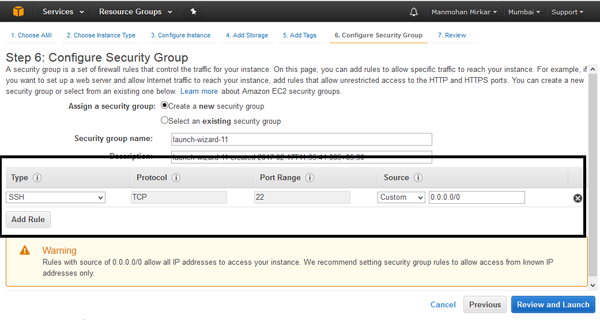
Configure AWS server
g. Select the "Review and Launch" button.
h. If all the details are correct, click the “Launch” button.
i. After clicking the "Launch" button, the system will pop up a window to create a "key pair" as shown below: Select the option "create a new key pair" and give the key pair name and download it. This key pair is required when connecting to the server using ssh. Finally, click the Launch Instance button.
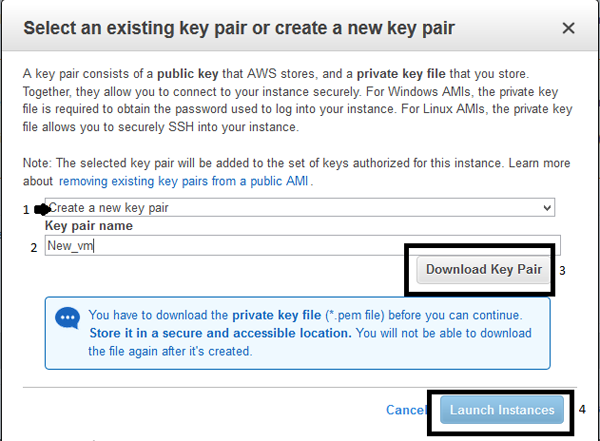
Create Key pair
j. After clicking the "Launch Instance" button, go to the service in the upper left corner. Select "compute" –> "EC2". Now click on "Running Instances":
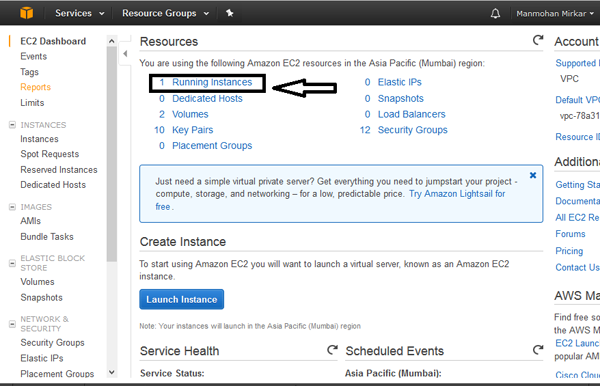
Go to the running EC2 instance
k. Now you can see that the status of your new VM is "running". Select the instance and note the Public DNS name required to log in to the server.
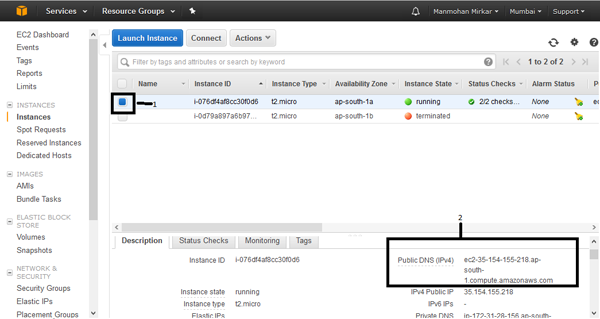
Public DNS value of the VM
Now you have finished creating a VM running Linux. To connect to the server, follow the steps below.
Connecting to an EC2 instance from Windows
1. First, you need putty gen and Putty exe to connect to the server from Windows (or SSH command on Linux). You can download putty via the link below.
2. Now open putty gen: puttygen.exe.
3. You need to click the “Load” button, browse and select the key pair file (pem file) you downloaded from Amazon.
4. You need to select the “ssh2-RSA” option and click the Save Private Key button. Please select "yes" in the next pop-up window.
5. Save the file with the extension .ppk.
6. Now you need to open putty.exe. Click "connect" in the left menu, then select "SSH" and then "Auth." You need to click the Browse button to select the .ppk file we created in step 4.
7. Now click on the “session” menu and in “host name” paste the DNS value from step “k” in this tutorial and click on the “open” button.
8. When asked for a username and password, enter ec2-user and a blank password, and then enter the following command.
$ sudo su -
Haha, you are now the owner of a Linux server hosted on the AWS cloud.
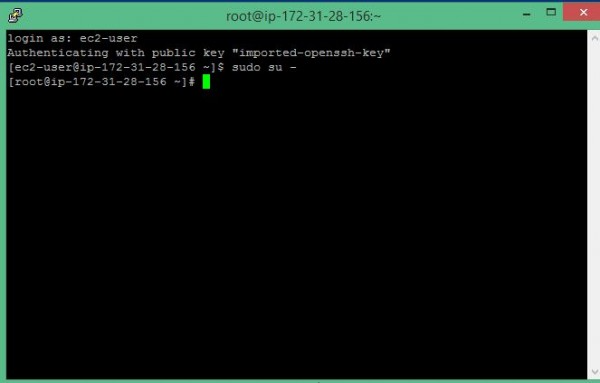
The above is the detailed content of An easy tutorial to create and configure a Linux virtual machine on AWS. For more information, please follow other related articles on the PHP Chinese website!

Hot AI Tools

Undresser.AI Undress
AI-powered app for creating realistic nude photos

AI Clothes Remover
Online AI tool for removing clothes from photos.

Undress AI Tool
Undress images for free

Clothoff.io
AI clothes remover

Video Face Swap
Swap faces in any video effortlessly with our completely free AI face swap tool!

Hot Article

Hot Tools

Notepad++7.3.1
Easy-to-use and free code editor

SublimeText3 Chinese version
Chinese version, very easy to use

Zend Studio 13.0.1
Powerful PHP integrated development environment

Dreamweaver CS6
Visual web development tools

SublimeText3 Mac version
God-level code editing software (SublimeText3)

Hot Topics
 1386
1386
 52
52
 How to use docker desktop
Apr 15, 2025 am 11:45 AM
How to use docker desktop
Apr 15, 2025 am 11:45 AM
How to use Docker Desktop? Docker Desktop is a tool for running Docker containers on local machines. The steps to use include: 1. Install Docker Desktop; 2. Start Docker Desktop; 3. Create Docker image (using Dockerfile); 4. Build Docker image (using docker build); 5. Run Docker container (using docker run).
 How to view the docker process
Apr 15, 2025 am 11:48 AM
How to view the docker process
Apr 15, 2025 am 11:48 AM
Docker process viewing method: 1. Docker CLI command: docker ps; 2. Systemd CLI command: systemctl status docker; 3. Docker Compose CLI command: docker-compose ps; 4. Process Explorer (Windows); 5. /proc directory (Linux).
 Difference between centos and ubuntu
Apr 14, 2025 pm 09:09 PM
Difference between centos and ubuntu
Apr 14, 2025 pm 09:09 PM
The key differences between CentOS and Ubuntu are: origin (CentOS originates from Red Hat, for enterprises; Ubuntu originates from Debian, for individuals), package management (CentOS uses yum, focusing on stability; Ubuntu uses apt, for high update frequency), support cycle (CentOS provides 10 years of support, Ubuntu provides 5 years of LTS support), community support (CentOS focuses on stability, Ubuntu provides a wide range of tutorials and documents), uses (CentOS is biased towards servers, Ubuntu is suitable for servers and desktops), other differences include installation simplicity (CentOS is thin)
 What to do if the docker image fails
Apr 15, 2025 am 11:21 AM
What to do if the docker image fails
Apr 15, 2025 am 11:21 AM
Troubleshooting steps for failed Docker image build: Check Dockerfile syntax and dependency version. Check if the build context contains the required source code and dependencies. View the build log for error details. Use the --target option to build a hierarchical phase to identify failure points. Make sure to use the latest version of Docker engine. Build the image with --t [image-name]:debug mode to debug the problem. Check disk space and make sure it is sufficient. Disable SELinux to prevent interference with the build process. Ask community platforms for help, provide Dockerfiles and build log descriptions for more specific suggestions.
 What computer configuration is required for vscode
Apr 15, 2025 pm 09:48 PM
What computer configuration is required for vscode
Apr 15, 2025 pm 09:48 PM
VS Code system requirements: Operating system: Windows 10 and above, macOS 10.12 and above, Linux distribution processor: minimum 1.6 GHz, recommended 2.0 GHz and above memory: minimum 512 MB, recommended 4 GB and above storage space: minimum 250 MB, recommended 1 GB and above other requirements: stable network connection, Xorg/Wayland (Linux)
 vscode cannot install extension
Apr 15, 2025 pm 07:18 PM
vscode cannot install extension
Apr 15, 2025 pm 07:18 PM
The reasons for the installation of VS Code extensions may be: network instability, insufficient permissions, system compatibility issues, VS Code version is too old, antivirus software or firewall interference. By checking network connections, permissions, log files, updating VS Code, disabling security software, and restarting VS Code or computers, you can gradually troubleshoot and resolve issues.
 Detailed explanation of docker principle
Apr 14, 2025 pm 11:57 PM
Detailed explanation of docker principle
Apr 14, 2025 pm 11:57 PM
Docker uses Linux kernel features to provide an efficient and isolated application running environment. Its working principle is as follows: 1. The mirror is used as a read-only template, which contains everything you need to run the application; 2. The Union File System (UnionFS) stacks multiple file systems, only storing the differences, saving space and speeding up; 3. The daemon manages the mirrors and containers, and the client uses them for interaction; 4. Namespaces and cgroups implement container isolation and resource limitations; 5. Multiple network modes support container interconnection. Only by understanding these core concepts can you better utilize Docker.
 What is vscode What is vscode for?
Apr 15, 2025 pm 06:45 PM
What is vscode What is vscode for?
Apr 15, 2025 pm 06:45 PM
VS Code is the full name Visual Studio Code, which is a free and open source cross-platform code editor and development environment developed by Microsoft. It supports a wide range of programming languages and provides syntax highlighting, code automatic completion, code snippets and smart prompts to improve development efficiency. Through a rich extension ecosystem, users can add extensions to specific needs and languages, such as debuggers, code formatting tools, and Git integrations. VS Code also includes an intuitive debugger that helps quickly find and resolve bugs in your code.




